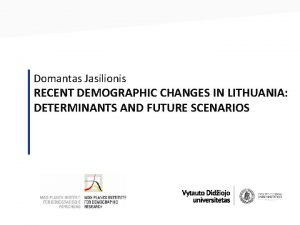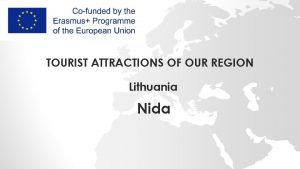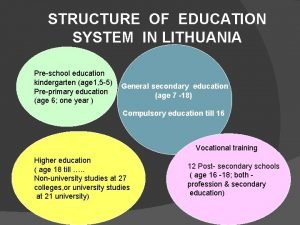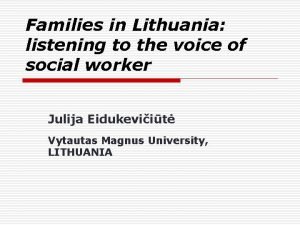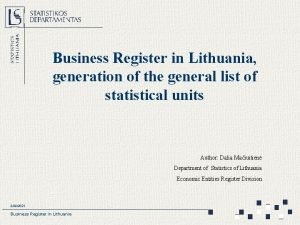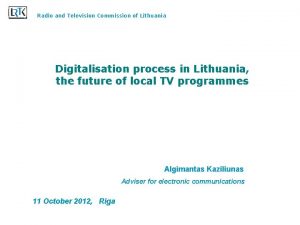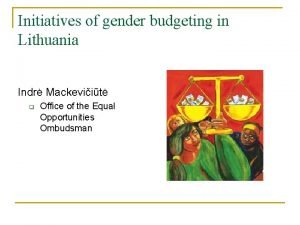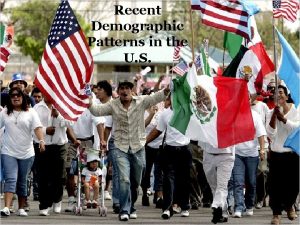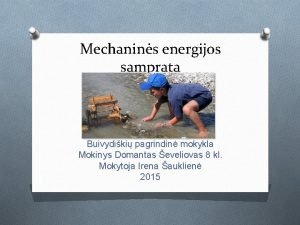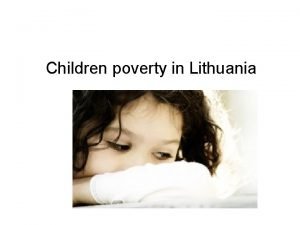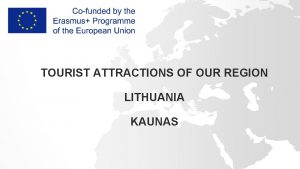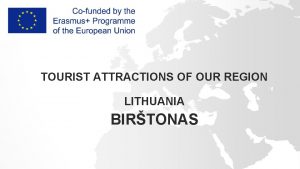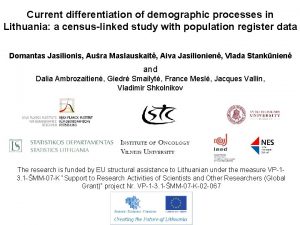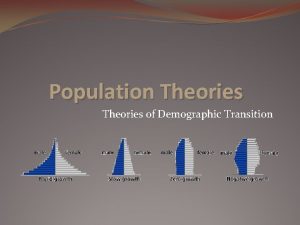Domantas Jasilionis RECENT DEMOGRAPHIC CHANGES IN LITHUANIA DETERMINANTS




























- Slides: 28

Domantas Jasilionis RECENT DEMOGRAPHIC CHANGES IN LITHUANIA: DETERMINANTS AND FUTURE SCENARIOS

DEMOGRAPHIC RESEARCH CENTRE _ The only Demographic Research Centre in Lithuania Headed by Prof. Vlada Stankūnienė. 5 post-doctoral researchers. Aim: to study changes and determinants of demographic processes (fertility, family, mortality, public health, migration, population structures, and ageing) in the historical, modern, and future perspectives. Member of Population Europe Network Past and ongoing projects with: - UN, OECD, European Commission, other int. organizations. - Leading international demographic research institutes Close partnership with Statistics Lithuania and other governmental bodies.

DEMOGRAPHIC PROCESSES AND STRUCTURES _ Population change and age composition are formed by the three major demographic processes: - fertility – births - mortality – deaths - migration – net-migration numbers Past and present demographic processes determines current and future age composition of a population. Demographic rates vs. absolute numbers rates – intensities of a process absolute numbers – direct consequence for population size and structure

SPECIFICS OF MODERN DEMOGRAPHIC CHANGE IN DEVELOPED _ COUNTRIES Fertility and mortality: - gradual changes in the context of global processes such as improvement of education and changing economic structures . - short-time fluctuations: policies and economic crises - increasing disparities between and within countries - weakening relationship to national wealth (GDP) International migration: - unstable dynamics and difficult to measure - sensitive to changing political-economic context - increasing variety (labour, illegal work, refugees…) - increasing impact on population change.

DEMOGRAPHIC DISPARITIES AS OBSTACLE FOR SUSTAINABLE DEMOGRAPHIC CHANGE ___ National averages hide important disparities between social within societies. Unfavourable changes at the national level are related to concentration of problems in disadvantaged groups. Persisting or increasing disparities a threat for sustainable demographic change. Demographic vanguards with best situation show the way for improvements for remaining population groups.

FERTILITY: DEMOGRAPHIC DIVIDENDS FOR FUTURE ___

TOTAL FERTILITY RATE IN EUROPEAN UNION ___ TFR=2. 1 Ensures replacement of generations Total Fertility Rate Average number of children born per women Data sources: Statistics Lithuania, EUROSTAT, Human Fertility Database.

FERTILITY POST-PONEMENT INCREASE IN MEAN AGE AT FIRST BIRTH ___ Data sources: Statistics Lithuania, EUROSTAT, Human Fertility Database.

TOTAL FERTILITY RATE IN LITHUANIA, 1990 -2016 ___ TFR=2. 1 Ensures replacement of generations Data source: Statistics Lithuania.

INCREASING FERTILITY RATES IN THE CONTEXT OF LOWER ABSOLUTE NUMBERS OF BIRTHS Demographic dividend – born in the mid/late 1980 s at ages 27 -32 years in 2017 Since early 2000 s: 2 x lower numbers of births for lower number of women Data source: Statistics Lithuania.

LOWER NUMBERS OF BIRTHS – SMALLER COHORTS ENTERING LABOUR MARKET IN FUTURE Hypothetical number of 18 year olds, derived from births 18 years ago. Optimistic scenario, if: - All newborns survive - Stay in Lithuania. Data source: Statistics Lithuania.

FERTILITY INCREASE: WOMEN WITH HIGHER EDUCATION TAKE A LEAD? ___ Total Fertility Rate, 2001 - 2012. Average number of children born per women Percentage increase: Higher education: +70% Secondary education: +12% Lower than secondary: +9% Data source: Statistics Lithuania. Jasilionienė, Stankūnienė, Jasilionis, 2016.

INCREASING SHARES OF HIGHLY EDUCATED INCREASING DEMOGRAPHIC INFLUENCE __ Changes in % of women with high education, 2001 - 2012 Higher Secondary Lower Data source: Statistics Lithuania.

ADVANTAGES OF WOMEN WITH HIGHER EDUCATION __ -- more stable families = lower probability of divorce -- higher income -> higher economic safety -- higher gender equality at work and family -- better chances to combine work and childcare better chances for childbearing at more advanced ages

INTERNATIONAL MIGRATION: MAIN REASON OF RECENT POPULATION DECLINE ___

EMIGRATION: NO SIGNS OF SLOW DOWN 2016: ~50 thou. 2017 (8 months): ~42 thou. Complex process, different stages: Adaptation, settling, family reunification Strong migration networks in destination countries. Data source: Statistics Lithuania.

EMIGRATION: MAINLY ECONOMIC DRIVERS? ___ Lower educated: 40% higher emigration than among higher educated Higher Secondary Lower Data source: Statistics Lithuania. Unemployed: 50% higher emigration than among employed Employed Unemployed

IMIGRATION AS AN ANSWER TO DEMOGRAPHIC CHALLENGES? ___ So far: immigration figures mainly reflect return migration of Lithuanian citizens. Complicated immigration procedures. Focus of current debate: immigrants will help overcome demographic pressures for labour market. Target countries: CIS: Belarus, Ukraine, Russia No discussion on: - Short-term demographic benefits vs. moderate influence in a longer perspective - Direct and indirect costs (integration and family re-unification) - Ability to compete for highly qualified immigrants - Threats: failure to integrate, further social exclusion, illegal migrants - No systematic analyses of good and bad experiences

RETURN MIGRATION OF LITHUANIAN CITIZENS: NO HOPE FOR REAL RETURN? ___ More than 100 thou. returns of Lithuanian citizens during 2011 -2016 Data source: Statistics Lithuania.

IS REINTEGRATION OF RETURN MIGRANTS WORKING? ___ Former migration experience 2. 2 x higher emigration chances No migration experience Experience of migration Data source: Statistics Lithuania.

MORTALITY: PERSISTING DISADVANTAGE IN MALE LIFE EXPECTANCY AT BIRTH ___

LIFE EXPECTANCY AT BIRTH IN EU COUNTRIES Persisting disadvantage in male life expectancy Data source: Statistics Lithuania, The Human Mortality Database, 2017.

High burden of deaths among males at working age ___ Share (%) of 30 year males dying before 65 th birthday Lithuania Estonia Czech R. Lithuania HIGH EDUC. Germany EVERY YEAR: ~5. 5 thou. avoidable deaths at working ages due to mortality disparity Economic losses France Data source: Statistics Lithuania Human Mortality Database

Source: UN, 2017. UN population projections Scenario: net-migration=0 TOTAL POPULATION OF LITHUANIA: 2015 -2100

Source: UN, 2017. UN population projections Scenario: net-migration=0 LABOUR FORCE, AGE RANGES: 15 -24 AND 25 -64 YEARS -100 thou. in less than 10 years.

CRITICAL POINTS AND CONCLUSIONS ___ Due to a huge decline in births in last two decades, Lithuania is ALREADY facing huge challenges, currently badly affecting its educational system and labour force supply with youngest generations. The problem is likely to become even more serious in coming years. Demographic dividend of the large birth cohorts born in the 1980 s will slightly counter-balance overall decrease in labour force in coming 1 -2 decades, but not in a longer perspective.

CRITICAL POINTS___ AND CONCLUSIONS What is the answer to demographic challenges? Systematic monitoring and forecasts Family policies creating better chances to combine work and childbearing at more advanced ages. Clever and realistic evidence-based immigration policies: estimation of benefits and costs understanding that immigration cannot solve demographic decline in a longer perspective.

ACKNOWLEDGEMENT ___ This study has been funded by Research Council of Lithuania. Project: Demographic decline in Lithuania: patterns and mechanisms in the context of generational change. Grant number: S-MIP-2017 -119.
 Domantas jasilionis
Domantas jasilionis Recent demographic changes in the uk
Recent demographic changes in the uk Elizabeth mulroney
Elizabeth mulroney Ano ang chemical change
Ano ang chemical change Lithuania czech republic
Lithuania czech republic Anna facchinetti
Anna facchinetti Lithuania popular sports
Lithuania popular sports Manpower lithuania
Manpower lithuania Lithuania cruise port
Lithuania cruise port Famous places in lithuania
Famous places in lithuania Vente lithuania
Vente lithuania Lithuania dmc
Lithuania dmc Romualdas trusovas
Romualdas trusovas Lithuania christmas tree
Lithuania christmas tree Sundial on parnidis dune, curonian spit, lithuania
Sundial on parnidis dune, curonian spit, lithuania Lithuanian grading system
Lithuanian grading system Feliksas dobrovolskis
Feliksas dobrovolskis Esn lithuania
Esn lithuania Lithuania caa
Lithuania caa Rural tourism in lithuania
Rural tourism in lithuania The voice of lithuania
The voice of lithuania Business register lithuania
Business register lithuania Communication lithuania
Communication lithuania Budgeting in lithuania
Budgeting in lithuania Can backdated udin be generated
Can backdated udin be generated Foreign trade
Foreign trade Recent activitycourse dashboard
Recent activitycourse dashboard Recent advances in ceramics
Recent advances in ceramics Recent developments in ict
Recent developments in ict
